
















Please login here to save this document to a list.
If you don't have an account, you can register for free here.
Strategy Frameworks Manual (PowerPoint PPT Slide Deck)
PowerPoint (PPT) 159 Slides
STRATEGY FRAMEWORKS PPT DESCRIPTION
This manual was developed to assist you as Strategy Group practitioners in your work on strategy projects by:
• Providing an overview of potentially useful strategic frameworks
• Describing when and where these might be used
• Explaining how to use them
• Giving examples of projects/cases where they have been successfully used in the past
• Suggesting people and sources that can help you further
This manual is structured to guide you through the strategy making process in a flexible way:
• Section 2: Analytical Process sets out a number of frameworks which can potentially be used to assist you in your strategic analysis and design. This section includes frameworks for use in the development of: Business Unit Strategy, Corporate Strategy and Functional Strategy
• Section 3: Project Process sets out a number of frameworks which can potentially be used to help you manage each stage of the strategy process. This section splits the project process into four key stages: Hypothesis Generation, Option Generation, Option Selection, Implementation
• Section 4: Other Useful Tools will in time grow to include other helpful information and tools to assist you on strategy projects/DDs. At this stage, we have included a section on Least Squares CAGRs
This manual also delves into the intricacies of various strategic tools like the Ansoff Matrix, Balanced Scorecard, and BCG Matrix, offering clear guidance on their application and relevance. You'll find detailed instructions on constructing and interpreting charts such as the RONA and Profit Pools, essential for financial analysis. The document covers critical mass industries and disruptive technologies, providing strategies to navigate these complex areas. With sections on distribution strategy and value chains, it ensures a comprehensive understanding of market dynamics. This manual is a robust resource for anyone looking to refine their strategic approach and drive business success.
Got a question about the product? Email us at support@flevy.com or ask the author directly by using the "Ask the Author a Question" form. If you cannot view the preview above this document description, go here to view the large preview instead.
Source: Best Practices in Strategy Frameworks PowerPoint Slides: Strategy Frameworks Manual PowerPoint (PPT) Presentation Slide Deck, Documents & Files
STRATEGY FRAMEWORKS PPT SLIDES
P&G's Strategic Value Chain and Outsourcing Approach
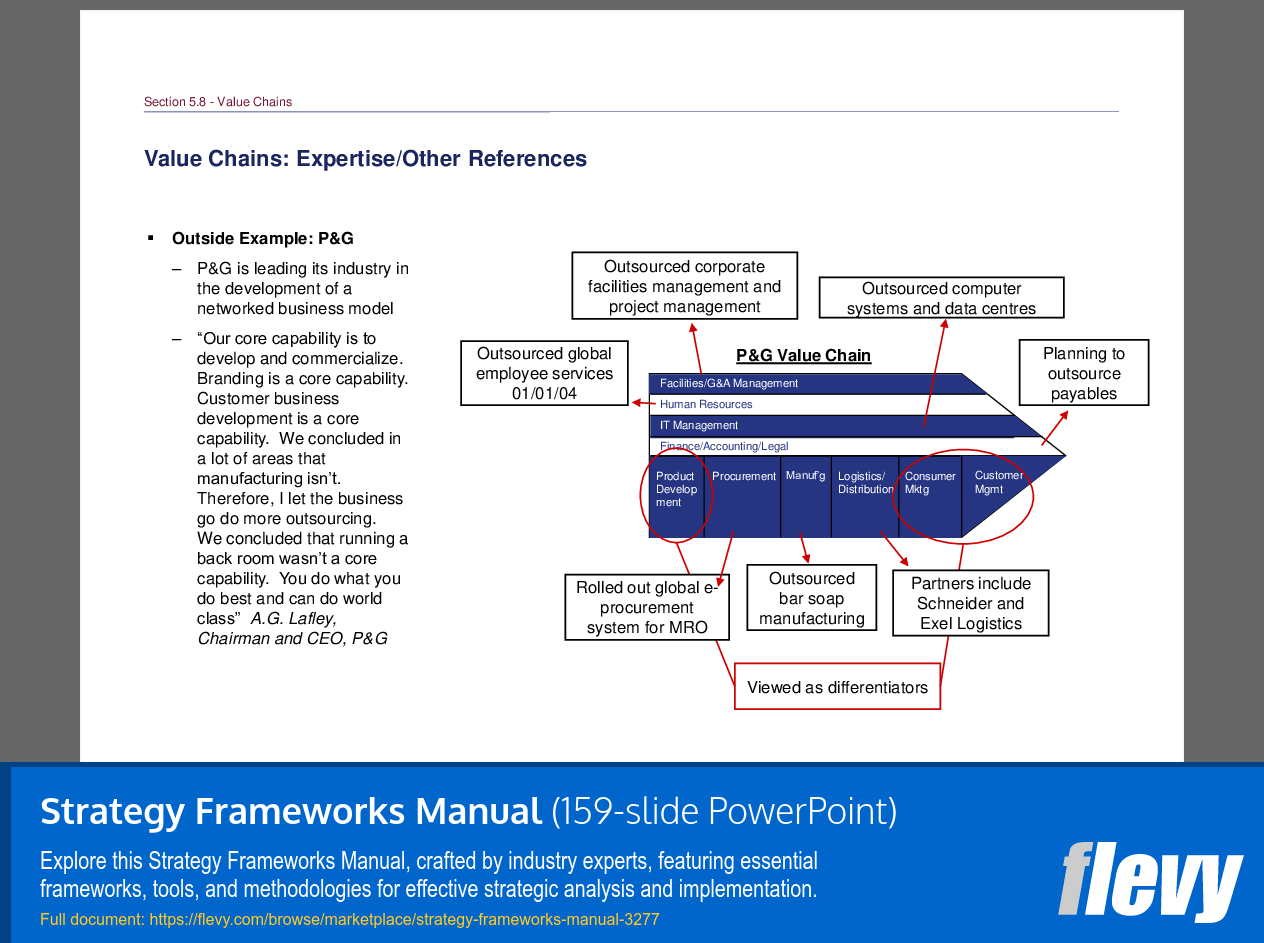
This PPT slide presents an analysis of value chains with a specific focus on Procter & Gamble (P&G) as a case study. It highlights P&G's leadership in adopting a networked business model, emphasizing the importance of core capabilities in developing and commercializing products. The quote from A.G. Lafley, P&G's Chairman and CEO, underlines the strategic decision to outsource non-core functions, allowing the company to concentrate on areas where it excels, such as branding and customer business development.
The P&G value chain diagram illustrates various functions, including product development, procurement, manufacturing, logistics, and customer marketing. Each function is linked to specific outsourced services, such as global employee services, corporate facilities management, and IT management. The slide indicates that P&G has rolled out an e-procurement system for maintenance, repair, and operations (MRO), which signifies a move towards efficiency and cost-effectiveness in procurement processes.
Additionally, the slide notes partnerships with companies like Schneider and Exel Logistics, which are viewed as differentiators in P&G's operational strategy. The planning to outsource payables suggests an ongoing commitment to streamline operations and enhance focus on strategic initiatives.
Overall, the content serves as a practical example for organizations looking to optimize their value chains by leveraging outsourcing and strategic partnerships. It encourages a reevaluation of core competencies and the potential benefits of adopting a similar approach to enhance operational efficiency and market responsiveness.
Understanding Scale's Impact on Profitability
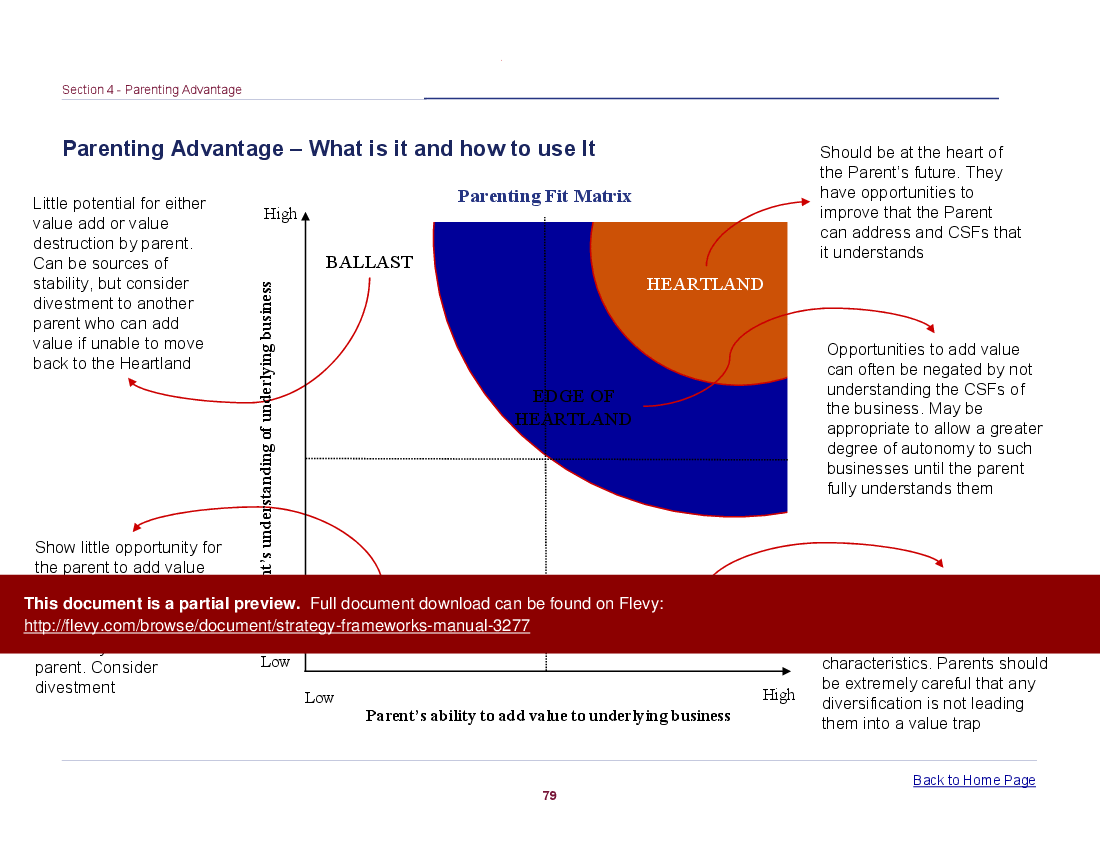
This PPT slide presents an analysis of the ROS/RMS (Return on Sales/Return on Market Share) matrix, focusing on how business size and experience influence profitability across various industries. It emphasizes the utility of ROS/RMS charts in making strategic decisions related to mergers and acquisitions, pricing strategies, and investment opportunities.
The text outlines 2 distinct scenarios based on the relationship between scale and profitability. In industries where scale significantly impacts profitability, examples include asset-rich sectors that require substantial machinery investments. These businesses benefit from spreading high fixed costs over a larger customer base, enhancing their financial performance. Similarly, companies that sell commodities or mass-market products, like grocery stores, rely on scale to negotiate lower prices, which can provide a competitive edge.
Conversely, the slide notes that not all sectors are influenced by scale. Businesses that focus on differentiated, luxury, or niche products tend to be less dependent on size for profitability. These companies often thrive on unique offerings that attract specific customer segments, allowing them to maintain higher margins without the need for extensive scale.
The visual representation on the slide further illustrates these points, with graphs indicating scenarios where scale drives profitability versus where it does not. This dual perspective equips executives with a framework for evaluating their strategic positioning within their respective industries. Understanding these dynamics can guide decision-making processes, ensuring that organizations align their growth strategies with market realities.
Understanding Disruption: The Disk Drive Evolution

This PPT slide illustrates the concept of disruptive technologies through the example of the disk drive market. It highlights the evolution of disk drives, emphasizing key performance parameters such as capacity and speed. Initially, the performance of traditional drives improves rapidly,, but this growth plateaus as the technology matures.
As laptops and desktops gain popularity, consumer demand shifts towards cheaper and lighter disk drives. This transition marks the emergence of a secondary niche market where these new drives compete, albeit initially underperforming against established traditional parameters. Over time, however, the capacity and speed of these lighter drives improve significantly due to increased production volumes and learning effects.
The narrative progresses to show that these cheaper and lighter drives eventually enter the mass market, surpassing traditional technology in terms of performance, even when compared to older models. This shift leads to the displacement of incumbent competitors, who fail to recognize the threat posed by these disruptive innovations.
The slide concludes with a cautionary note, indicating that this pattern has repeated multiple times within the disk drive sector, with incumbents consistently underestimating the disruptive potential of emerging technologies. This serves as a critical reminder for executives to remain vigilant and adaptable in the face of technological advancements that can reshape market dynamics.
Consumer Segmentation Strategies for Financial Services

This PPT slide focuses on the concept of attitudinal or behavioral segmentation, particularly in the context of financial services products. It begins by highlighting the importance of segmentation in tailoring product characteristics and marketing strategies to distinct consumer groups. Traditional demographic methods are critiqued for their limitations, as they fail to capture the nuances of consumer behavior and motivations.
The slide outlines how attitudinal or behavioral segmentation categorizes consumers based on their attitudes towards a product, both at the point of purchase and afterward. This approach allows companies to plot different consumer segments against key behavioral parameters, facilitating a deeper understanding of consumer needs. Identifying these segments enables businesses to assess the attractiveness of each group, considering factors like potential profitability, market size trends, and the ease of targeting based on existing competencies.
Four specific consumer segments are illustrated in a quadrant format: "Pressured Providers," "Confident Investors," "Traditionalists," and "Free Thinkers." Each segment is defined by their interest in the product and their expertise in buying. For example, "Pressured Providers" have a strong need for the product, but lack the time to conduct thorough research, suggesting that a more advisory marketing approach could be effective. This segmentation framework provides actionable insights for targeting and tailoring marketing strategies to meet the distinct needs of each group, ultimately enhancing engagement and conversion rates.
Balanced Scorecard Framework for Semiconductor Performance

This PPT slide presents a balanced scorecard framework tailored for a semiconductor company, emphasizing a multi-faceted approach to performance measurement. It outlines 4 key perspectives: Financial, Customer, Learning & Innovation, and Internal Business. Each perspective is linked to specific goals and corresponding measures, providing a structured way to assess progress and align activities with long-term value creation.
The Financial Perspective focuses on survival, success, and prosperity through metrics like cash flow, quarterly sales growth by division, and market share. This section highlights the importance of financial health as a foundation for sustainable growth.
The Customer Perspective emphasizes the need for new products and responsive supply chains. Metrics such as the percentage of sales from new and proprietary products, on-time delivery, and key account share indicate how well the company meets customer expectations. The note about understanding customer definitions of on-time delivery suggests a strategic shift in resource allocation to better serve demanding clients.
In the Learning & Innovation Perspective, goals revolve around technology leadership and product focus. Measures include time to develop the next generation of products and the percentage of sales from new introductions. This indicates a commitment to innovation and responsiveness to market needs.
The Internal Business Perspective stresses the importance of operational efficiency. Metrics like internal capability versus competition and cycle time highlight the need for continuous improvement in processes. The notes indicate that existing information systems may need enhancement to support these goals effectively.
Overall, this slide serves as a comprehensive guide for executives looking to implement a balanced scorecard approach, ensuring alignment across various business dimensions.
Framework for Retail Turnaround Strategy Stages
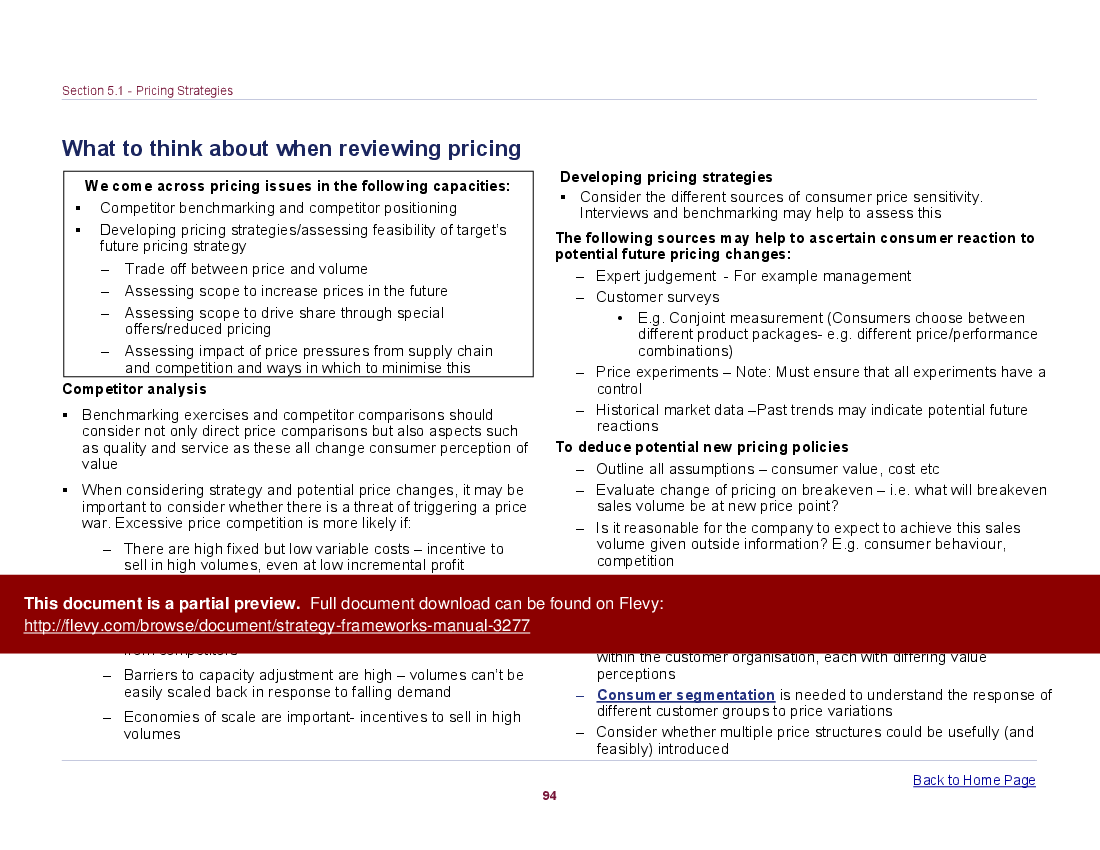
This PPT slide presents a framework for understanding the turnaround process of retail firms, particularly in the context of private equity investments. It outlines a structured model that progresses through 3 distinct stages aimed at revitalizing a struggling business. The initial position is characterized by low growth and profitability, setting the stage for necessary interventions.
The first stage focuses on reducing risk exposure for the private equity house. This is achieved by enhancing the firm's ability to manage its debts through improved cash flow. This foundational step is crucial, as it stabilizes the business and prepares it for subsequent growth initiatives.
In the second stage, the emphasis shifts to operational effectiveness and profitability. The model suggests that developing a strong store proposition is key to this phase. By refining operations, the business can transition from merely surviving to becoming profitable, albeit still with low growth.
The final stage is about promoting growth within the restructured business. Here, the focus is on formulating a viable exit strategy for the equity house, ensuring that the investment can be realized effectively. The slide visually represents this journey, with a growth and profit axis that illustrates the transition from the initial position to a fully turned-around business characterized by high growth and profitability.
This framework serves as a practical guide for stakeholders involved in retail turnaround strategies, providing a clear roadmap for navigating the complexities of business revitalization. It emphasizes the importance of structured stages and strategic focus, making it a valuable resource for decision-makers in this field.
Frameworks for Strategic Analysis and Implementation

This PPT slide presents a structured overview of various analytical frameworks categorized under Business Unit Strategy, Corporate Strategy, and Functional Strategy. Each category is further divided into specific areas of focus, providing a clear roadmap for strategic analysis.
Under the "Analysis/Diagnosis" section, frameworks like Consumer Segmentation and Customer Service Management are highlighted for understanding customer dynamics. Competitor analysis tools such as Pricing Umbrellas and Competitor Cost Structures are also included, indicating a comprehensive approach to evaluating market positioning. This suggests that understanding both customer and competitor landscapes is crucial for effective strategy formulation.
The "Creating Value" section emphasizes frameworks like the Ansoff Matrix and Business Models, which are essential for identifying growth opportunities and value creation strategies. The mention of Customer Service Management reiterates the importance of customer-centric approaches in driving business success.
"Capturing Value" focuses on Pricing strategies, indicating that effective pricing is a key lever for maximizing profitability. The "Sustaining Value" section introduces concepts like Customer Loyalty and the Balanced Scorecard, which are vital for long-term success and performance measurement.
The Corporate Strategy section includes well-known frameworks such as the BCG Matrix and SWOT analysis, which are fundamental for assessing organizational capabilities and market positioning. The Functional Strategy section rounds out the slide with a focus on Distribution and Sales Strategies, underscoring the operational aspects of executing the overall strategy.
Overall, the slide serves as a valuable reference for executives seeking to navigate the complexities of strategic planning and execution. It highlights the interconnectedness of various frameworks and their application in different strategic contexts.
Utilizing the Profit Tree for Strategic Profit Analysis
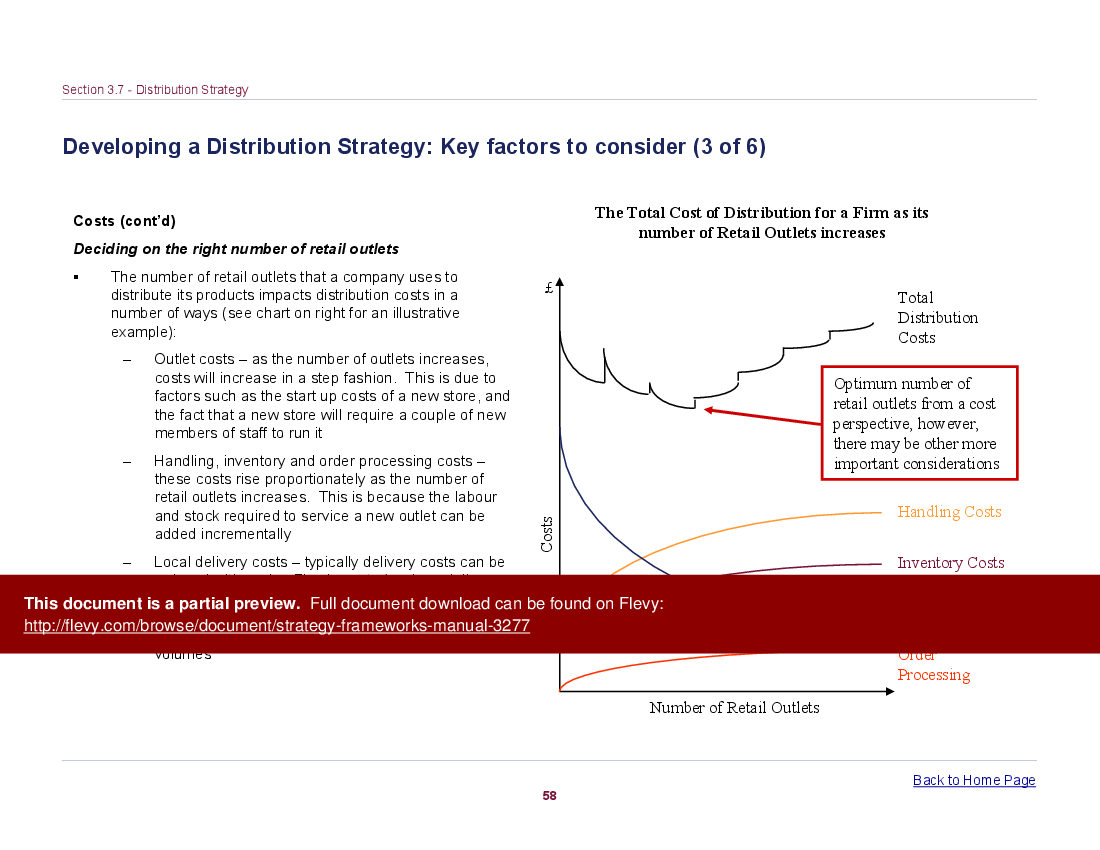
This PPT slide titled "Drivers of Value / Profit Tree: How to use it" presents a structured approach to analyzing profit growth through a profit tree model. It emphasizes the versatility of this model, indicating that it can be applied at both the industry and company levels. The visual layout categorizes key components influencing profit growth, primarily focusing on revenue and costs.
The slide illustrates that profit growth can occur without changes in the cost base, which is a critical insight for executives aiming to enhance profitability. The revenue growth is dissected into 2 main drivers: market growth and market share gain. The latter is particularly noteworthy as it highlights the role of decreasing competition in facilitating market share increases. This suggests that understanding competitive dynamics is essential for leveraging market opportunities.
The profit tree also breaks down revenue into 2 significant factors: price and volume. This bifurcation allows for a more granular analysis of how each element contributes to overall revenue. The visual indicators of increasing, neutral, and decreasing trends provide a quick reference for assessing each factor's performance.
The slide serves as a practical guide for executives looking to implement this analytical framework. It encourages a systematic examination of both internal and external factors affecting profit, ultimately aiding in strategic decision-making. By utilizing this model, organizations can identify specific areas for improvement, whether through pricing strategies, volume enhancements, or market positioning. The clarity and structure of the profit tree make it an effective tool for driving focused discussions around profit optimization.
Understanding Intermediary Roles in Distribution Strategy

This PPT slide presents a structured overview of various types of intermediaries involved in distribution strategy. It categorizes these intermediaries into distinct groups, illustrating their roles and relationships within the supply chain. At the core, manufacturers or producers initiate the process, connecting directly to sales offices or branches, which serve as points of contact for product distribution.
Brokers and agents are depicted as facilitators who do not take ownership of the goods, but play a crucial role in connecting manufacturers with other entities. Merchant wholesalers are identified as businesses that take title to the merchandise, engaging in activities such as selling, storing, and delivering products. This distinction is vital for understanding how different intermediaries operate within the market.
Retailers are positioned as the final intermediary before reaching ultimate consumers or business users. The slide emphasizes that retailers also do not take ownership of the products, but are essential in facilitating transactions. This flow of goods from manufacturers to consumers highlights the importance of each intermediary's function in the overall distribution strategy.
A key takeaway is the principle that the shorter the distribution channel, the greater the control a manufacturer has over the marketing process. This insight can guide strategic decisions regarding the selection of intermediaries and the design of distribution channels. Understanding these dynamics is crucial for optimizing distribution strategies and enhancing market reach. The slide effectively encapsulates the relationships and functions of intermediaries, serving as a valuable reference for executives focused on distribution optimization.
Strategic Growth Options: Ansoff Matrix Overview

This PPT slide presents the Ansoff Matrix, a strategic tool designed to assess potential growth avenues for a business. It outlines 4 fundamental strategies that organizations can pursue to drive growth.
The first option is to grow existing products in existing markets, known as Market Penetration. This strategy focuses on increasing market share and maximizing sales from current offerings. The second option involves introducing new products into existing markets, termed Product Development. This approach allows businesses to leverage their established customer base while diversifying their product lines.
The third strategy is Market Development, which entails entering new markets with existing products. This can involve geographical expansion or targeting new customer segments. The final strategy is Diversification, where companies develop new products and introduce them into new markets. This is often seen as the riskiest option, as it requires both product innovation and market exploration.
The matrix is visually structured into 4 quadrants, each representing one of the strategies. The axes are labeled with Present Products and New Products on the horizontal axis, and Present Markets and New Markets on the vertical axis. This clear layout helps executives quickly identify and evaluate their strategic options.
Understanding these strategies is crucial for any organization looking to navigate growth challenges. The Ansoff Matrix provides a straightforward framework for decision-making, enabling leaders to align their resources and efforts effectively. This slide serves as a foundational reference for strategic planning discussions, making it a valuable addition to any management toolkit.
Decoding RONA: Key Metrics and Interpretations
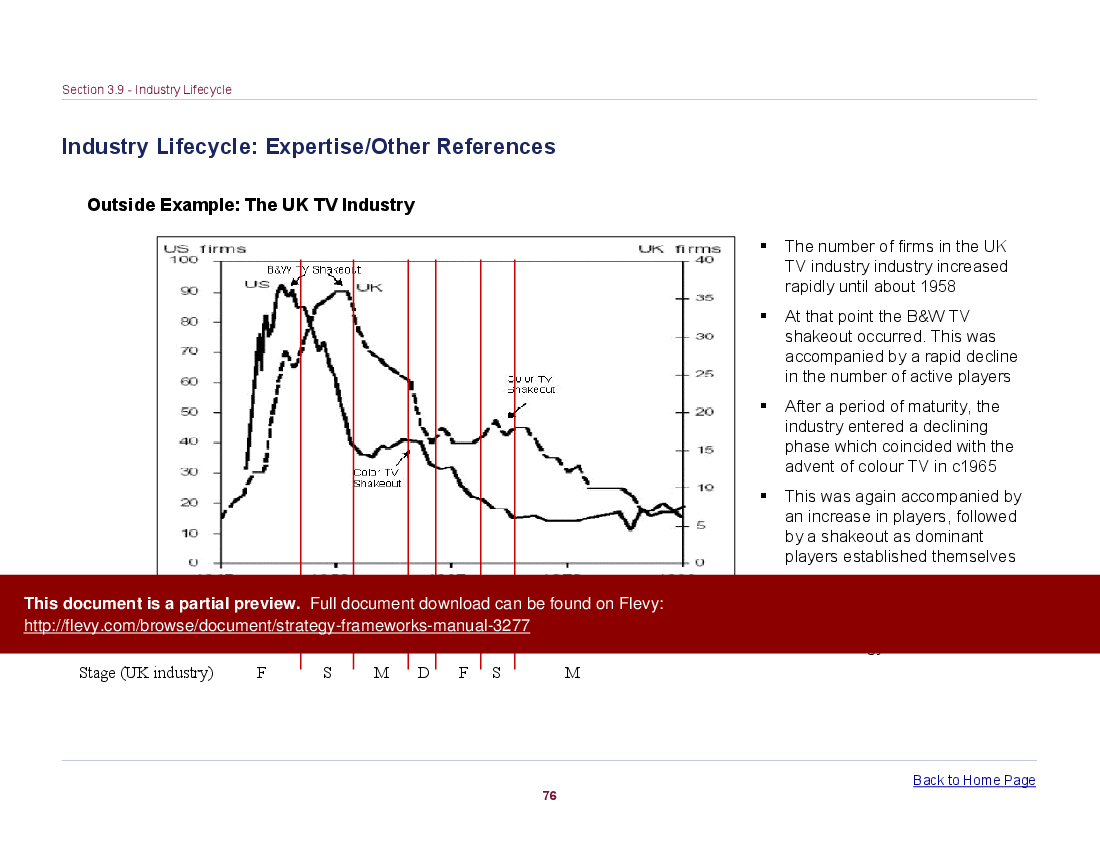
This PPT slide provides a detailed breakdown of RONA (Return on Net Assets) and its components, emphasizing how this metric can be dissected into its fundamental elements. It illustrates the relationships between Return on Sales, Net Asset Turnover, and PBIT (Profit Before Interest and Taxes). The left section outlines the formulae that connect these elements, indicating that RONA can be expressed as a product of Return on Sales and Net Asset Turnover.
Net Asset Turnover is defined as the frequency with which a company’s capital is converted into sales revenue over a specific period. This metric is crucial for understanding how effectively a business utilizes its assets to generate revenue. The slide suggests that the turnover can be further analyzed through a pyramid of ratios, which can reveal underlying issues affecting asset turnover. For instance, poor management of debtors or cash and overinvestment in plant and machinery are highlighted as potential factors that could hinder performance.
The right section of the slide delves into the specifics of asset turnover, breaking it down into categories such as Sales/Working Capital and Sales/Fixed Assets. This segmentation allows for a more granular analysis of how different asset classes contribute to overall turnover. The slide also notes that metrics can include various constituents of the asset base, providing flexibility in measurement.
Overall, the content is designed to equip executives with a framework for interpreting RONA charts, enabling them to identify areas for improvement in asset utilization and operational efficiency. Understanding these metrics can lead to informed decision-making and strategic adjustments.
Strategic Positioning: Cost Leadership vs. Differentiation
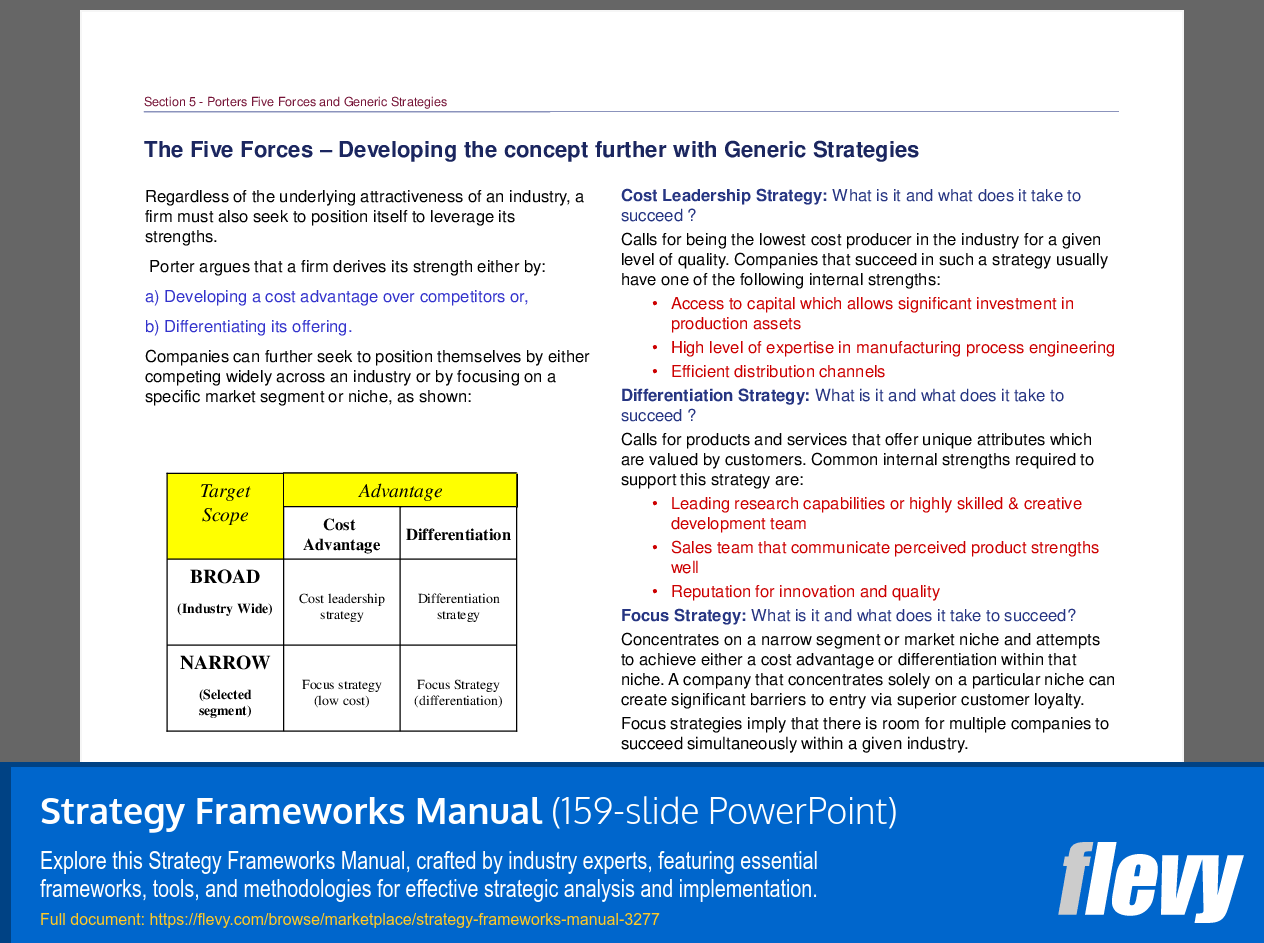
This PPT slide outlines Porter's Five Forces framework, emphasizing the importance of strategic positioning for firms within an industry. It asserts that a company's strength can be derived from either achieving a cost advantage over competitors or differentiating its offerings. The framework categorizes strategies into broad and narrow scopes, highlighting how firms can either compete across an entire industry or focus on specific market segments.
The slide presents 2 primary strategies: Cost Leadership and Differentiation. The Cost Leadership Strategy is defined as the pursuit of being the lowest cost producer in the industry while maintaining a certain quality level. Success in this strategy typically hinges on internal strengths such as access to capital for significant investment in production assets and expertise in manufacturing processes. Efficient distribution channels also play a crucial role.
On the other hand, the Differentiation Strategy focuses on offering unique attributes that are valued by customers. Companies that excel in this area often possess leading research capabilities or a highly skilled development team. Effective communication of product strengths by the sales team and a reputation for innovation and quality are also essential.
The slide further introduces the Focus Strategy, which targets a narrow segment or niche. This strategy aims to achieve either a cost advantage or differentiation within that specific market. Companies adopting this approach can create barriers to entry for competitors through superior customer loyalty. The implication is that there is potential for multiple firms to thrive within a given industry, provided they effectively leverage their unique strengths.
Understanding Critical Mass in Market Penetration

This PPT slide presents the concept of critical mass industries, focusing on the relationship between actual and perceived market penetration. It illustrates how these 2 factors interact and influence customer behavior. The graph depicts a curve where actual penetration is plotted against perceived penetration, highlighting a tipping point where the 2 metrics align. This point signifies the 'critical mass' threshold, beyond which a product can enter a virtuous growth cycle.
The slide emphasizes that customer reactions vary based on their perception of product value relative to actual penetration. When actual penetration is lower than perceived, customers may feel disappointed, leading to negative word-of-mouth and reduced adoption rates. Conversely, when actual penetration exceeds perceived penetration, customers tend to be satisfied, encouraging further usage and recommendations.
Key insights include the importance of understanding different customer segments. Early adopters may engage with a product even when penetration is low, while others may wait for higher penetration levels before committing. This behavior is crucial for strategizing market entry and growth.
The shape of the curve is also significant; small differences in positioning can dramatically impact whether a product succeeds or fails. The slide warns that until critical mass is achieved, there is a risk of declining penetration. Once this threshold is crossed, the product can rapidly gain traction and benefit from a self-reinforcing growth cycle. This framework provides a strategic lens for evaluating market opportunities and guiding product development decisions.
Evaluating Grand Met's Strategic Business Alignment
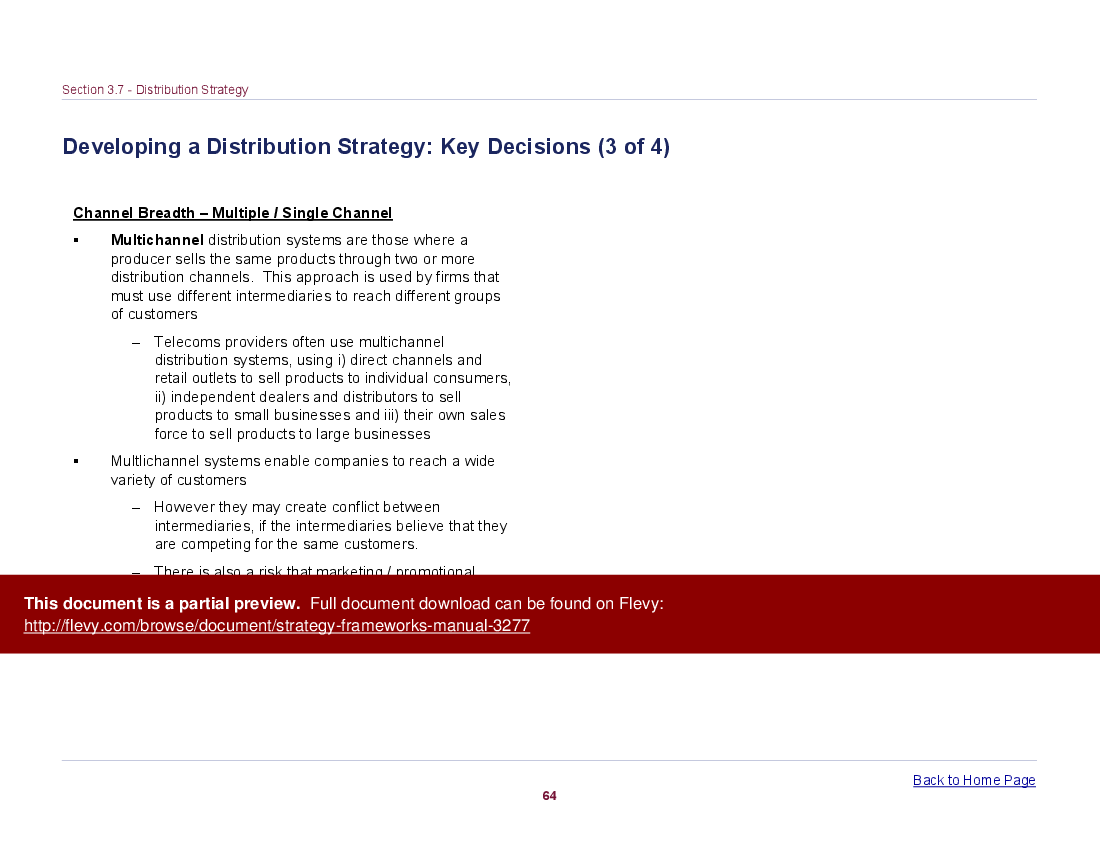
This PPT slide presents a historical analysis of Grand Met's corporate strategy in 1992, focusing on its diverse business portfolio and the concept of "parenting advantage." The Grand Met Parenting Fit Matrix is central to this analysis, illustrating the company's understanding of its various businesses and its ability to add value to them.
The matrix categorizes businesses into 4 quadrants based on 2 axes: the parent’s understanding of the underlying business and the parent’s ability to add value. The upper right quadrant highlights "Premium Drinks," indicating a strong alignment between Grand Met's capabilities and the business's needs. This suggests that Grand Met had effectively leveraged its expertise in building and marketing global drinks brands, ultimately leading to a strategic focus on this area.
Conversely, the lower left quadrant features "Burger King," which represents a misalignment. Grand Met lacked a tangible parenting advantage in the fast-food industry, leading to a lack of understanding and eventual divestment despite Burger King's profitability. This highlights the risks associated with diversifying into areas without adequate expertise.
The slide also discusses the acquisition of the Pillsbury food company, emphasizing how Grand Met's skills evolved through managing poorly invested brands. The turnaround of UK brewing is noted as a success story, illustrating how the company could add value once it understood the business better.
Overall, the slide effectively communicates the importance of aligning corporate strategy with core competencies and understanding the underlying businesses to maximize value creation. It serves as a reminder of the complexities involved in managing a diverse portfolio and the necessity of strategic focus.
Optimal Pricing Strategies Based on Customer Value
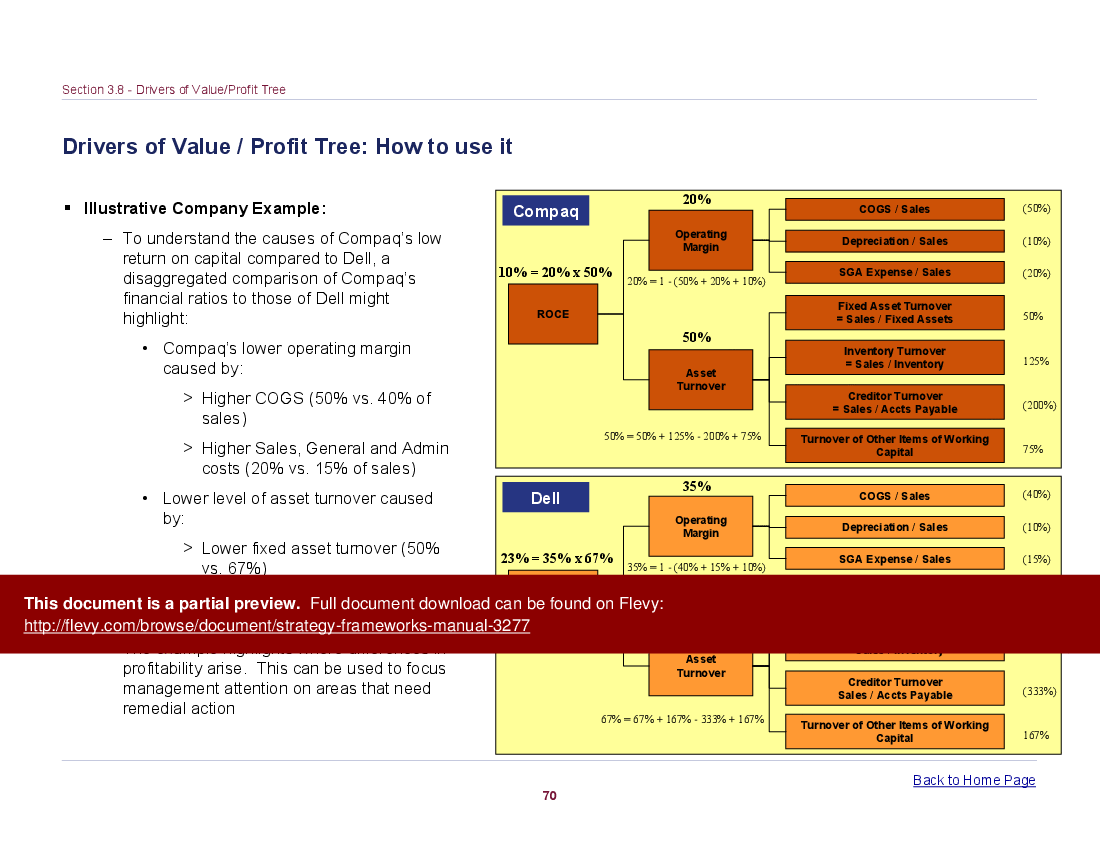
This PPT slide focuses on pricing strategies, emphasizing their critical role in driving profitability. It highlights that a 10% increase in price can yield a greater profit increase than a similar rise in volume or a reduction in costs. This establishes the foundation for understanding how to set prices effectively.
The slide outlines key questions that need to be addressed when determining product pricing. It stresses the importance of understanding the value of a product to the consumer. Questions such as the significance of product attributes, the potential price premium based on those attributes, and the brand's support for pricing decisions are central to this analysis.
A graphical representation illustrates the relationship between price, cost, and performance. The graph shows how the value to the customer diminishes after reaching a certain performance level, indicating that while performance can be enhanced, the incremental value perceived by the consumer may not increase proportionately. This suggests that there is an optimal price point where the gap between the price that can be charged and the cost to produce the product is maximized.
The slide also notes that the cost of performance often increases non-linearly. As performance improvements are made, the cost to produce may rise more steeply, complicating pricing decisions. This reinforces the need for a strategic approach to pricing, balancing the perceived value to the customer against production costs to identify the optimal pricing strategy. Overall, the content provides a structured framework for executives to consider when making pricing decisions, ensuring they align with both market expectations and internal cost structures.
Balanced Scorecard: Aligning Strategy with Performance Metrics

This PPT slide presents a framework known as the Balanced Scorecard, which outlines the cause-and-effect relationships that define a strategy. It emphasizes the importance of aligning various perspectives to achieve an organization’s vision and strategy.
At the top of the slide, the overarching theme is "Vision and Strategy," indicating that all perspectives are interconnected and aimed at fulfilling the company's strategic goals. The first perspective is the Financial Perspective, which poses the question of how success will be perceived by shareholders. This perspective serves as a measure of whether the company's strategic initiatives are effectively contributing to financial performance.
Next is the Customer Perspective, which focuses on how the company is viewed by its customers. It seeks insights into customer perceptions and expectations, emphasizing the need to understand what customers value to ensure ongoing loyalty and satisfaction.
The Internal Perspective follows, asking what processes must excel to meet customer needs. This highlights the significance of internal operations and efficiencies in delivering value to customers. It suggests that managing these processes is crucial for maintaining a positive customer perspective.
Finally, the Learning & Innovation Perspective addresses how the organization can learn and improve to achieve its vision. This perspective underscores the necessity of continuous improvement and adaptation in a rapidly changing environment.
Overall, the Balanced Scorecard serves as a comprehensive tool for organizations to align their strategic objectives across various dimensions, ensuring that all efforts contribute to a unified vision. This approach not only enhances performance, but also fosters a culture of accountability and continuous improvement.
Understanding the BCG Matrix for Strategic Portfolio Management

This PPT slide presents an overview of the BCG Matrix, a strategic tool used to evaluate the positioning of various business units or products within a portfolio. It highlights the matrix's utility in assessing both the attractiveness of individual businesses and the overall health of the portfolio. A balanced portfolio should consist of a mix of cash generators and cash users.
The slide categorizes business units into 4 distinct quadrants: Stars, Question Marks, Cash Cows, and Dogs. Stars are units that generate significant cash, but require ongoing investment to maintain their position. If successful, they can transition into cash generators as market growth slows. Question Marks are uncertain investments needing cash to grow market share, with potential for success if properly funded. Cash Cows, on the other hand, require minimal investment while generating cash that can be allocated to other units. However, they must still receive enough investment to remain competitive. Finally, Dogs do not generate significant cash and may need to be divested to reallocate resources more effectively.
Common uses of the BCG Matrix include corporate strategy projects for organizations with multiple business units. It serves as a framework for resource allocation, understanding strategic importance within a portfolio, and comparing performance against competitors. The matrix helps executives make informed decisions about where to invest, which units to nurture, and which to divest, ultimately guiding the strategic direction of the organization.
Understanding the Balanced Scorecard Framework

This PPT slide presents an overview of the Balanced Scorecard, emphasizing its role in performance assessment beyond traditional financial metrics. It critiques the reliance on financial measures, which, while effective for evaluating past performance, fail to provide insights into a company's future trajectory. The Balanced Scorecard addresses this gap by incorporating various perspectives that influence future financial outcomes.
The slide outlines 4 key perspectives: Financial, Customer, Internal Business, and Innovation & Learning. Each perspective is structured to include specific goals and measures, highlighting the interconnectedness of these areas in driving overall performance. The visual representation suggests a holistic approach, where each perspective feeds into the others, creating a comprehensive framework for evaluation.
Key points stress the importance of senior management involvement in establishing goals and performance measures. This engagement ensures that the metrics are relevant and aligned with the organization's strategic vision. The slide advises against an overwhelming number of metrics, advocating for a focused set of well-thought-out goals within each perspective. This approach promotes clarity and effectiveness in measuring performance.
The final note emphasizes that the goals and measures should reflect the organization’s strategy rather than merely controlling employee actions. This insight is crucial for executives considering the Balanced Scorecard as a tool for strategic management. It suggests that a well-implemented Balanced Scorecard can lead to better alignment of organizational activities with strategic objectives, ultimately enhancing performance.
Interpreting Sector Charts: Market Dynamics Overview

This PPT slide presents a framework for interpreting sector charts, highlighting 3 distinct market types: Fragmented, Consolidating, and Mature Consolidated markets. Each market type is illustrated with a graphical representation that includes circles of varying sizes, indicating the relative performance and market share of different competitors.
In the Fragmented Market section, the chart shows numerous small players, with a significant portion of sales attributed to "Others." This indicates a diverse competitive environment where no single entity dominates. The text notes that company growth is unevenly distributed, suggesting that the overall market dynamics are unlikely to shift significantly in the near future.
Moving to the Consolidating Market, the chart depicts a mix of company sizes, from large to small. Here, the largest companies are noted to be growing at rates above the market average, while smaller firms are lagging behind. This trend implies that over time, larger players will increasingly capture a greater share of the market, indicating a gradual consolidation process.
Lastly, the Mature Consolidated Market illustrates a scenario where a few large players dominate the landscape, with "Others" making up a minimal portion of total sales. Growth rates in this market are closely aligned with the average, reinforcing the notion that significant changes in market dynamics are not anticipated.
This slide serves as a valuable tool for understanding market structures and dynamics, providing insights into how companies may position themselves strategically within these frameworks.
Leveraging S-Curves for Strategic Market Insights
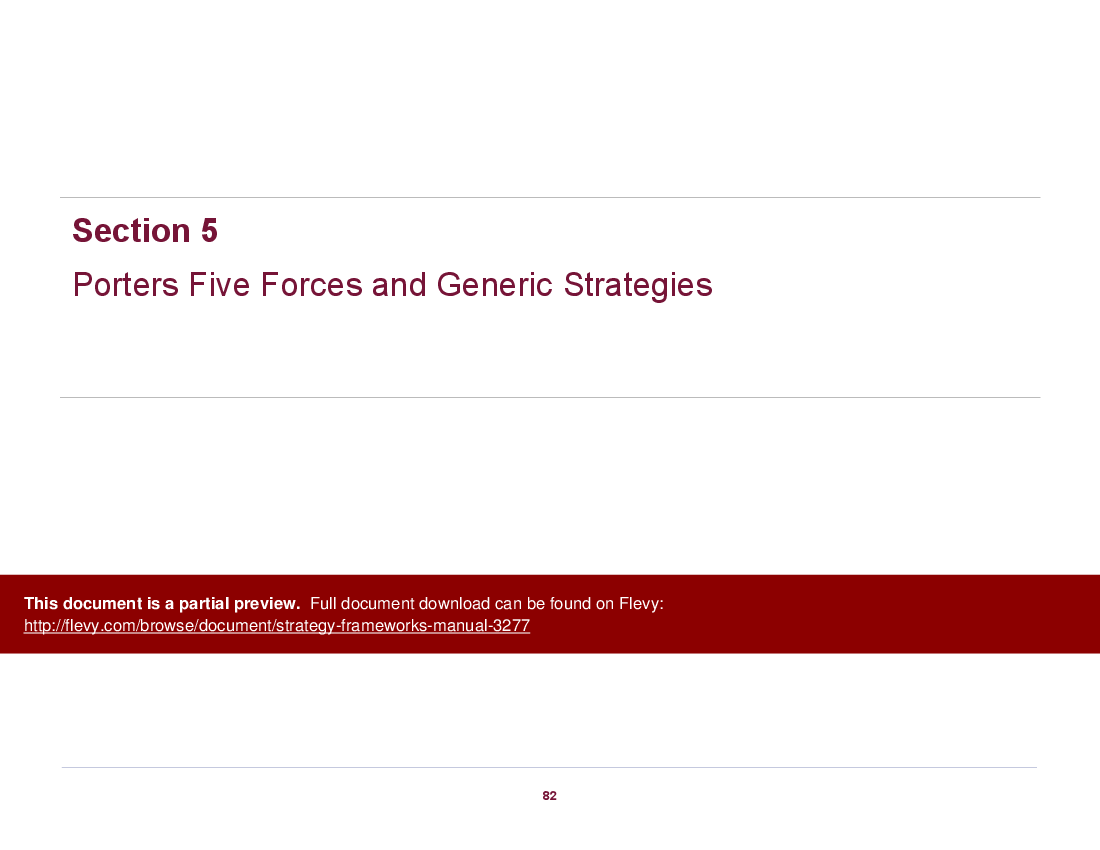
This PPT slide presents a framework for understanding S-curves and their relevance to market penetration strategies. It outlines how organizations can leverage insights from S-curves to identify growth opportunities and assess product positioning within its lifecycle. The first section emphasizes the importance of determining where a product currently stands on its S-curve and what actions are necessary to advance it. This involves analyzing the potential return on investment from R&D and marketing expenditures, which are critical for propelling growth.
The slide also highlights the different focus areas required at various stages of the product lifecycle. For instance, early stages may demand more aggressive marketing and R&D efforts to capture market share effectively. The accompanying Investment S-Curve graph visually represents these stages, illustrating the relationship between investment and product maturity.
In the context of due diligence, the slide stresses the need for a thorough business plan analysis. Key questions include the product's lifecycle status, the adequacy of support it receives, and the existence of complementary products that could facilitate growth.
The discussion on competitor analysis reveals insights into first mover advantages, noting that while early market entrants can benefit from exponential growth, they may not sustain long-term advantages. This is due to the susceptibility of incumbents to disruptive technologies and the perception of lower risks for new entrants in established markets.
Overall, the slide serves as a strategic guide for executives to evaluate growth prospects and make informed decisions regarding product development and market strategies.
Evaluating Corporate Parenting Strategies for Business Units

This PPT slide presents the "Parenting Advantage" framework, which assists corporations in making strategic decisions regarding their business portfolios. It focuses on 2 key questions: which businesses to own and how to maximize value from those businesses. The framework encourages mapping the corporate portfolio onto a "Parenting Fit Matrix," which is referenced, but not shown in detail.
The slide outlines a structured approach for evaluating the relationship between a corporate parent and its subsidiaries. It emphasizes understanding both the parent's characteristics and the critical success factors (CSFs) of the business units. This dual understanding is crucial for assessing potential value addition and identifying areas where value might be unintentionally diminished.
The framework categorizes potential outcomes into 2 main areas: high potential to add value and low potential to destroy value. For high potential scenarios, it prompts analysis of how the parent’s resources and skills can enhance the subsidiary’s opportunities. Conversely, in low potential situations, it highlights the importance of aligning on CSFs to avoid friction that could hinder value creation.
An additional validation step is suggested, urging corporations to reflect on past successes in similar contexts. This retrospective analysis can provide insights into the effectiveness of the parenting approach and guide future decisions.
Overall, the Parenting Advantage framework offers a systematic method for corporations to evaluate their business units and make informed decisions about acquisitions, divestments, or skill development. This structured approach can lead to more strategic alignment and improved performance across the portfolio.
Strategies to Reduce Critical Mass for Product Success

This PPT slide presents strategies aimed at decreasing critical mass to enhance a product’s likelihood of success. It begins by emphasizing the importance of reducing the critical mass threshold that a product must reach to enter a growth phase. The visual representation illustrates how shifting the critical mass curve to the left can facilitate this process, allowing products to gain traction at lower levels of actual penetration.
The slide outlines 6 specific strategies that can be employed to achieve this goal. Each strategy is paired with a rationale, providing clarity on its intended impact. The first strategy suggests creating incentives for early adopters. This approach leverages the influence of early adopters as indicators of product viability, encouraging broader acceptance.
Investing in complementary products is another strategy highlighted. This not only enhances the product's appeal, but also builds an ecosystem that can attract more users. Pursuing critical mass in niche markets is presented as a viable option when mass market penetration proves challenging.
The slide also recommends making products compatible with existing successful offerings. This strategy aims to tap into established user bases, thereby increasing the product's attractiveness. Lastly, introducing a new product standard to compete against a rival's successful platform is suggested as a means to reclaim market share.
Overall, the slide effectively communicates actionable strategies for reducing critical mass, providing a clear framework for executives looking to boost their product's market entry success. The insights offered here can serve as a foundation for strategic discussions and decision-making processes.
Impact of Retail Outlets on Distribution Costs
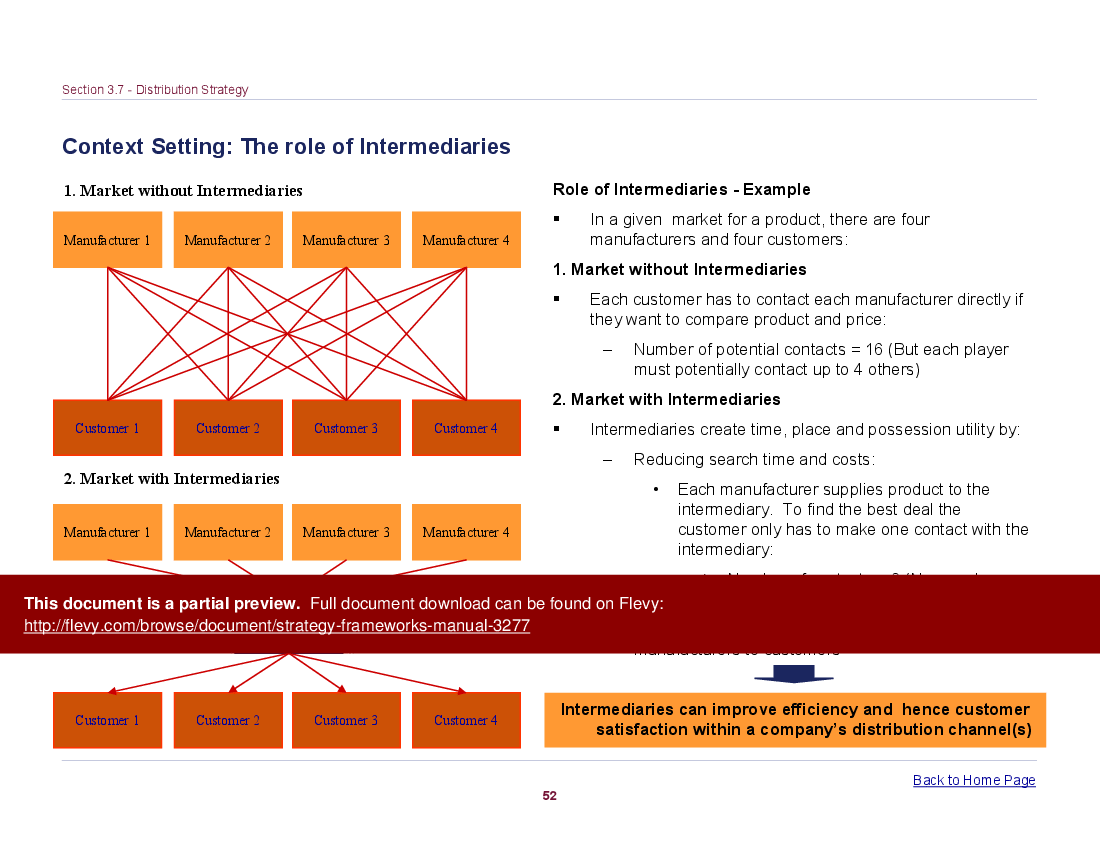
This PPT slide presents a detailed analysis of how the number of retail outlets influences distribution costs for a company. It emphasizes that as a business expands its retail presence, various cost components will be affected in distinct ways. The chart on the right visually illustrates the relationship between the total distribution costs and the number of retail outlets.
Initially, outlet costs are highlighted as a significant factor. As more outlets are opened, these costs increase in a stepwise manner, primarily due to initial setup expenses and the need for additional staff. This suggests that businesses must carefully consider the financial implications of each new outlet.
The slide also addresses handling, inventory, and order processing costs. These costs are shown to rise proportionately with the increase in retail outlets. The implication is clear: as a company scales its operations, it must manage the complexities associated with servicing additional locations. This includes not only labor, but also the stock needed to support each outlet.
Local delivery costs are presented as an area where efficiencies can be gained. The slide notes that these costs can decrease with scale, as fixed assets like delivery vehicles can be utilized more effectively across a larger number of outlets. Additionally, partnering with logistics providers can lead to better rates, further enhancing cost efficiency.
The slide concludes with a cautionary note about the "optimum number of retail outlets." While cost considerations are critical, the text suggests that other factors may also play a vital role in determining the ideal distribution strategy. This insight encourages executives to look beyond mere numbers and consider broader strategic implications when planning their retail distribution networks.
Key Considerations for Effective Distribution Strategy

This PPT slide outlines critical decisions involved in developing a distribution strategy, focusing on channel length and breadth. It highlights 3 main factors influencing channel length: customer requirements, account concentration, and the degree of control over direct customer contact.
Customer requirements emphasize the need for direct relationships in cases where service and repair are crucial. For instance, industries like aerospace may necessitate direct engagement due to the complexity and specificity of customer needs. Conversely, account concentration suggests that when a few customers dominate sales, direct selling is more efficient. In contrast, broader markets, like consumer goods, benefit from indirect channels, allowing retailers to manage multiple products and customer relationships.
The slide also discusses channel breadth, specifically the intensity of distribution. It categorizes distribution into 3 types: exclusive, selective, and intensive. Exclusive distribution involves a limited number of distributors, often used for specialty goods. This approach can enhance dealer loyalty and provide manufacturers with greater control over distribution. However, market dynamics can shift, making exclusive arrangements less viable, as seen in the automotive sector where consumers increasingly prefer diverse purchasing options.
Overall, the slide serves as a guide for executives to consider how to structure their distribution strategy effectively. It underscores the importance of aligning distribution choices with customer needs and market conditions, ultimately influencing sales performance and customer satisfaction. Understanding these elements can help organizations make informed decisions that enhance their market presence and operational efficiency.
Optimizing Revenue through Pricing Strategies
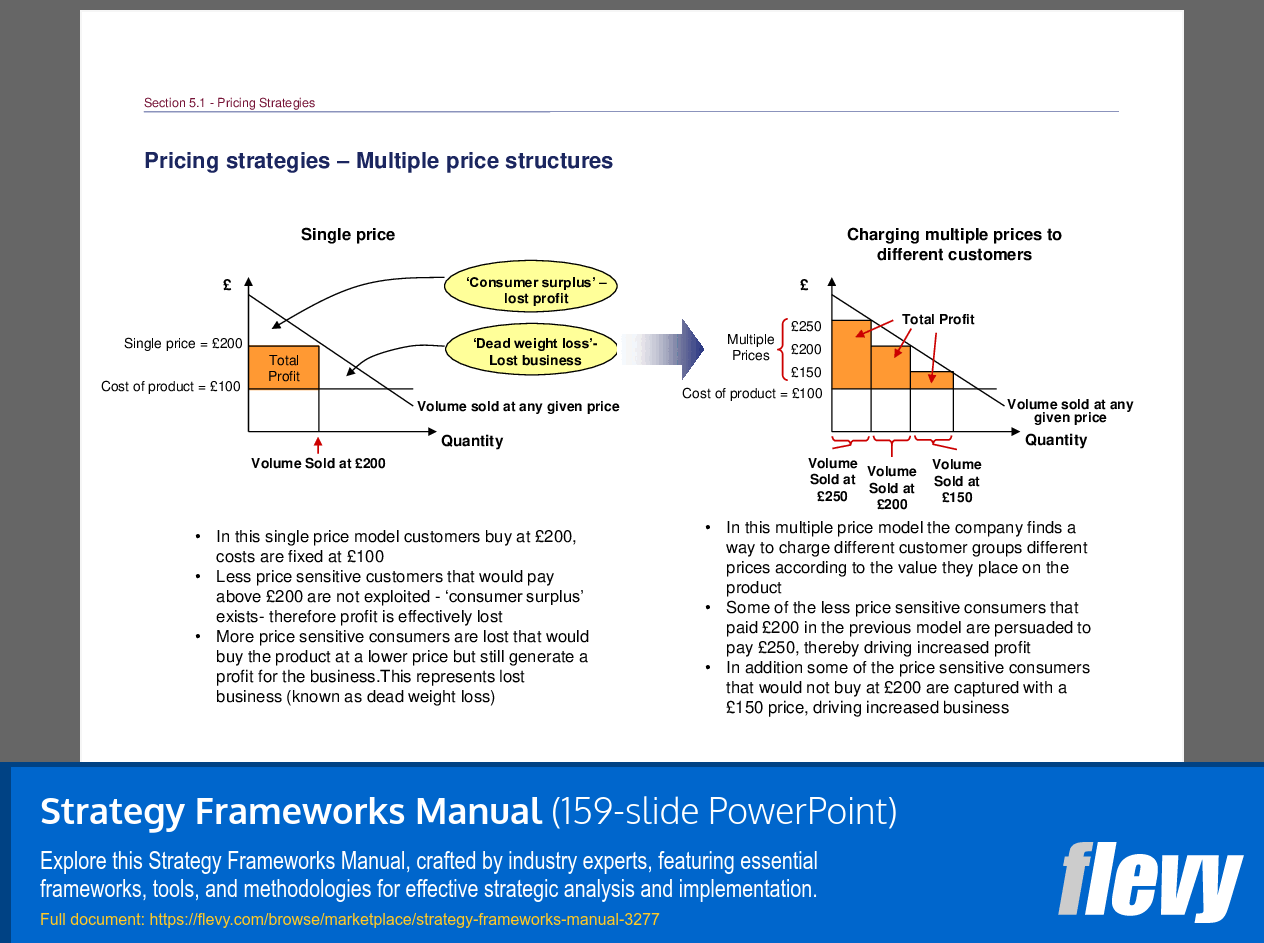
This PPT slide presents a comparative analysis of pricing strategies, specifically focusing on single pricing versus multiple price structures. On the left side, the single price model is illustrated, where a product is priced at £200, with a fixed cost of £100. This model highlights 2 key issues: the concept of 'consumer surplus,' which refers to potential profit lost because some customers are willing to pay more than £200, and 'dead weight loss,' which indicates business that could have been captured from price-sensitive consumers who would purchase at a lower price.
The graph accompanying the single price model shows that while total profit is maximized at a certain volume sold, there are segments of the market that remain untapped. This results in a loss of potential revenue from customers who value the product higher than the set price, but are not incentivized to purchase.
On the right, the multiple price model is introduced. Here, the company can charge different prices—£250, £200, and £150—based on customer willingness to pay. This strategy allows the business to capture more value from less price-sensitive customers while also appealing to more price-sensitive segments. The slide notes that some customers who previously paid £200 may now be willing to pay £250, thus increasing overall profit. Additionally, those who would not buy at £200 can be attracted at a £150 price point, leading to increased sales volume.
The insights from this slide suggest that employing a multiple pricing strategy can effectively enhance revenue by better aligning prices with customer value perception.
Strategic Framework for Market Definition Exploration

This PPT slide presents the "Market Definition Dartboard," a strategic tool designed to assist organizations in clarifying their market positioning and enhancing discussions within management teams. It outlines 2 primary use cases: first, to inform internal work and challenge existing business assumptions; second, to facilitate management meetings aimed at exploring perceptions of the market.
The section labeled "When to use it" emphasizes the tool's versatility. It suggests that the dartboard can be employed to broaden thinking about the business and to engage management in a reflective dialogue about their market definitions. This is crucial for understanding how flexible the management team is in defining their market scope.
The slide provides practical guidance for using the dartboard in management meetings. It recommends starting with the question, "which business are we in?" This approach encourages teams to consider a range of alternatives and assess the breadth of their market definition. The slide also suggests probing deeper with questions like, "how could we define our market more broadly?" This encourages a more expansive view and can lead to valuable insights.
Furthermore, the slide highlights the importance of discussing key implications of different market definitions. It points to 3 critical areas: identifying competitive sets and threats, uncovering potential growth opportunities, and recognizing essential skills needed to compete effectively. This structured approach not only fosters strategic thinking, but also aligns the management team on critical market dynamics, ultimately aiding in informed decision-making.
Understanding Competitor Cost Structures for Strategic Insights

This PPT slide presents insights into competitor cost structures, emphasizing that there is no standardized output for such analyses. The effectiveness of the analysis hinges on 2 primary factors: the scope of the analysis and the availability of data. It is crucial to define what the analysis aims to achieve to tailor the approach accordingly.
The slide advocates for visual representation of results, suggesting that charts should be utilized to convey findings effectively. This method allows for easier comprehension of complex data. The content of the charts can include various cost components associated with different activities in the value chain, such as sourcing, picking, packaging, and distribution. These costs can be expressed as a percentage of sales, either for specific targets or across a broader industry range.
The right side of the slide features a chart titled "Benchmark Ranges for Costs as a % of Sales for a Newspaper Company." This chart illustrates how different cost categories—editorial, production, advertising, marketing, and back office—are represented as a percentage of sales. The highlighted area indicates a significant range for editorial costs, which spans from 8% to nearly 16% of sales. This visual representation underscores the variability in cost structures across different activities and provides a benchmark for comparison.
Understanding these cost structures is vital for strategic decision-making. It enables organizations to identify areas for improvement and optimize their operations. The insights derived from this analysis can guide executives in making informed decisions that align with their business objectives.
Utilizing the Ansoff Matrix for Strategic Growth

This PPT slide outlines the Ansoff Matrix, a qualitative tool designed to assist businesses in evaluating potential growth strategies. The matrix is structured into 4 quadrants, each representing different growth options based on existing products and markets. The slide emphasizes the importance of starting with a clear definition of the current business, which should be placed in the top left corner of the matrix.
The first option, labeled as the least risky, involves leveraging existing competencies and resources. This approach may face challenges such as market saturation or regulatory constraints, particularly if the product is in a mature stage of its lifecycle. The second and third options focus on developing new products or entering new markets, which depend heavily on the company's core competencies. For instance, firms with strong R&D capabilities might pursue product development, while those with robust marketing strategies may seek to expand into new markets.
The fourth option, diversification, is highlighted as the most risky. This strategy is best suited for businesses with adaptable cultures that can manage the inherent uncertainties of entering entirely new markets or product lines. The slide also notes common applications of the Ansoff Matrix, such as generating ideas for future growth, assessing the feasibility of various strategies, and deciding which growth paths to pursue.
Overall, the Ansoff Matrix serves as a practical framework for executives to systematically evaluate growth opportunities, balancing risk and potential reward in their strategic planning.
Understanding Core Competencies for Strategic Advantage

This PPT slide outlines the concept of core competencies, which serve as the foundation for a firm's strategic positioning. It defines core competencies as discrete activities, skills, technologies, or assets that a company excels in, providing significant customer value and facilitating access to various markets. This definition emphasizes the importance of differentiation in a competitive environment.
The slide categorizes core competencies into several areas, including technologies, brands, processes, IT infrastructure, managerial systems, training and education, and knowledge structures. Each category is illustrated with examples, such as Intel’s microprocessor for technology and Coca-Cola for branding. This variety highlights how core competencies can manifest across different aspects of a business, reinforcing the idea that they are not limited to product offerings alone.
An example from Canon is presented, showcasing how its core competencies connect to various end products like copiers and cameras. This visual representation illustrates the interrelationship between core competencies and product offerings, suggesting that understanding these competencies can guide strategic decisions regarding product development and market expansion.
The slide concludes with insights on the value of identifying core competencies. It suggests that they are crucial for determining which strategies can leverage a firm's strengths and assessing the sustainability and potential for extending these strengths into new areas. This information is vital for executives looking to refine their strategic approach and ensure long-term viability in their respective markets.
ABOUT THE AUTHOR
Ask the Author a Question
You must be logged in to contact the author.
|
|
"I am extremely grateful for the proactiveness and eagerness to help and I would gladly recommend the Flevy team if you are looking for data and toolkits to help you work through business solutions."
– Trevor Booth, Partner, Fast Forward Consulting
|
|
|
"FlevyPro provides business frameworks from many of the global giants in management consulting that allow you to provide best in class solutions for your clients."
– David Harris, Managing Director at Futures Strategy
|
|
|
"My FlevyPro subscription provides me with the most popular frameworks and decks in demand in today’s market. They not only augment my existing consulting and coaching offerings and delivery, but also keep me abreast of the latest trends, inspire new products and service offerings for my practice, and educate me ... [read more] in a fraction of the time and money of other solutions. I strongly recommend FlevyPro to any consultant serious about success. "
– Bill Branson, Founder at Strategic Business Architects
|
|
|
"Last Sunday morning, I was diligently working on an important presentation for a client and found myself in need of additional content and suitable templates for various types of graphics. Flevy.com proved to be a treasure trove for both content and design at a reasonable price, considering the time I ... [read more] saved. I encountered a download issue during the ordering process. However, a quick email to Flevy's support team, even on a Sunday (!!!), resulted in assistance within less than an hour, allowing me to download the content I needed. Fantastic job, Flevy! I give 5 stars for both content/price and customer service. Thank you! "
– M. E., Chief Commercial Officer, International Logistics Service Provider
|
|
|
"One of the great discoveries that I have made for my business is the Flevy library of training materials.
As a Lean Transformation Expert, I am always making presentations to clients on a variety of topics: Training, Transformation, Total Productive Maintenance, Culture, Coaching, Tools, Leadership Behavior, etc. Flevy ... [read more] usually has just what I need to make my point.
"
It is well worth the money to purchase these presentations. Sure, I have the knowledge and information to make my point. It is another thing to create a presentation that captures what I want to say. Flevy has saved me countless hours of preparation time that is much better spent with implementation that will actually save money for my clients. – Ed Kemmerling, Senior Lean Transformation Expert at PMG
|
|
|
"Flevy is our 'go to' resource for management material, at an affordable cost. The Flevy library is comprehensive and the content deep, and typically provides a great foundation for us to further develop and tailor our own service offer."
– Chris McCann, Founder at Resilient.World
|
|
|
"I have found Flevy to be an amazing resource and library of useful presentations for lean sigma, change management and so many other topics. This has reduced the time I need to spend on preparing for my performance consultation. The library is easily accessible and updates are regularly provided. A wealth of great information."
– Cynthia Howard RN, PhD, Executive Coach at Ei Leadership
|
|
|
"As a young consulting firm, requests for input from clients vary and it's sometimes impossible to provide expert solutions across a broad spectrum of requirements. That was before I discovered Flevy.com.
Through subscription to this invaluable site of a plethora of topics that are key and crucial to consulting, I ... [read more] have been able to exceed expectations and deliver quality advice and solutions to my clients. The quality and expertise of the authors are exemplary and gives me great confidence to use as part of my service offerings.
"
I highly recommend this company for any consultant wanting to apply international best practice standards in their service offerings. – Nishi Singh, Strategist and MD at NSP Consultants
|
